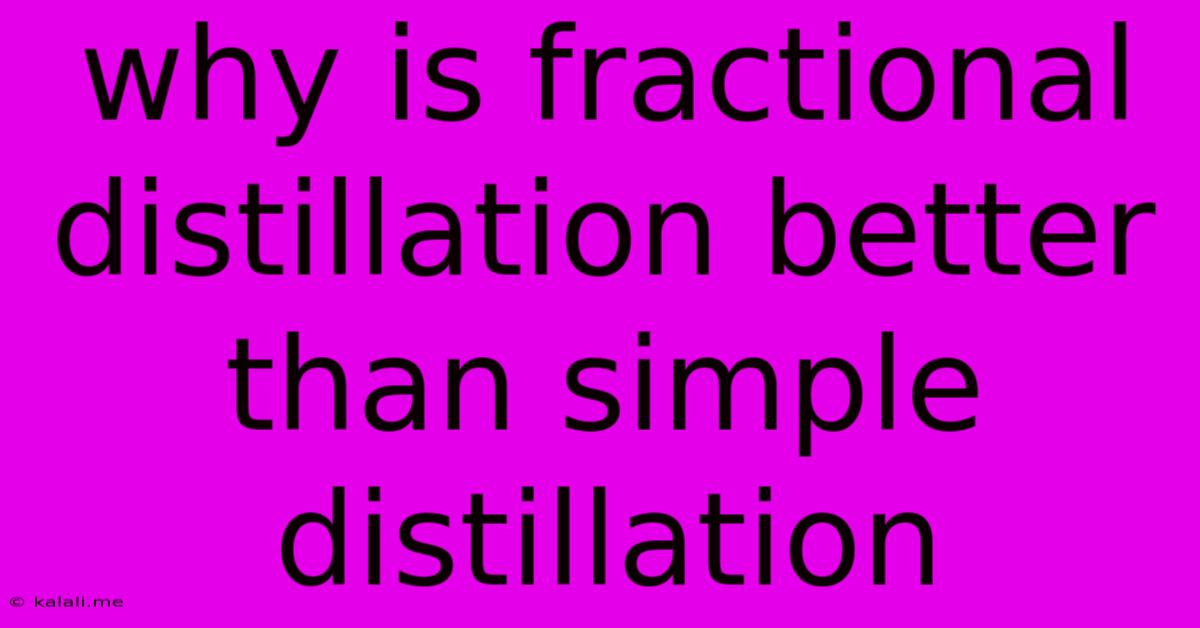Why Is Fractional Distillation Better Than Simple Distillation
Kalali
May 10, 2025 · 3 min read

Table of Contents
Why Fractional Distillation Reigns Supreme: A Deep Dive into its Advantages over Simple Distillation
Fractional distillation and simple distillation are both techniques used to separate mixtures of liquids based on their boiling points. However, fractional distillation significantly outperforms simple distillation, particularly when separating liquids with boiling points close together. This article will delve into the reasons why fractional distillation is the preferred method in numerous applications. This detailed comparison will explore the core differences and highlight the superior efficiency of fractional distillation.
Fractional distillation is superior to simple distillation because it achieves a much higher degree of separation, especially for mixtures of liquids with similar boiling points. This is achieved through the use of a fractionating column, which provides a greater surface area for vapor-liquid equilibrium to occur.
The Core Difference: The Fractionating Column
The key difference lies in the presence of a fractionating column in fractional distillation. This column, often packed with glass beads or other materials, provides a large surface area for vapor-liquid equilibrium to occur repeatedly. Simple distillation, on the other hand, lacks this crucial component.
How Fractional Distillation Works: A Multi-Stage Process
As the vapor rises in the fractionating column, it cools and condenses on the packing material. This condensate then re-evaporates as it is heated by rising hotter vapor. This process of vaporization and condensation, known as reflux, occurs many times along the column. Each cycle of vaporization and condensation increases the purity of the vapor. Liquids with lower boiling points will tend to reach the top of the column and be collected first.
Why Simple Distillation Falls Short
Simple distillation is effective for separating liquids with significantly different boiling points (at least 70-80°C apart). However, when the boiling points are closer, simple distillation produces a distillate that is a mixture of both liquids, not a pure substance. The vapor above the boiling mixture will still contain a significant amount of the higher-boiling component. This results in an impure product and reduces the efficiency of the separation process.
Advantages of Fractional Distillation Summarized:
- Higher Purity: Achieves a much higher degree of separation, leading to purer products, especially for mixtures with similar boiling points.
- Improved Efficiency: Separates mixtures more effectively, leading to a greater yield of the desired component.
- Better Separation of Close-Boiling Liquids: Unlike simple distillation, it excels at separating liquids with boiling points close to one another.
- Wide Applicability: Used in various industrial processes and laboratory settings requiring precise separation of liquid mixtures.
Real-World Applications Highlighting the Importance of Fractional Distillation:
Fractional distillation is integral to various industrial processes:
- Crude Oil Refining: Separating crude oil into various fractions like gasoline, kerosene, and diesel.
- Liquor Production: Purifying ethanol from fermented solutions.
- Petrochemical Industry: Separating different hydrocarbons.
- Natural Gas Processing: Separating different components of natural gas.
In conclusion, fractional distillation's superior ability to separate liquids with closely related boiling points makes it indispensable across numerous scientific and industrial applications. The use of a fractionating column, facilitating repeated vapor-liquid equilibrium, leads to a significantly improved separation efficiency and higher product purity compared to simple distillation. While simple distillation might suffice for certain applications involving liquids with vastly different boiling points, fractional distillation is the superior choice for more demanding separations.
Latest Posts
Latest Posts
-
Step Up To The Streets Final Dance
Jul 06, 2025
-
How Many Grams Is Half An Oz
Jul 06, 2025
-
How Much Is 10 Quarters In Dollars
Jul 06, 2025
-
How Do You Beat Stage 9 On Bloxorz
Jul 06, 2025
-
What Is 1 2 Equivalent To In Fractions
Jul 06, 2025
Related Post
Thank you for visiting our website which covers about Why Is Fractional Distillation Better Than Simple Distillation . We hope the information provided has been useful to you. Feel free to contact us if you have any questions or need further assistance. See you next time and don't miss to bookmark.